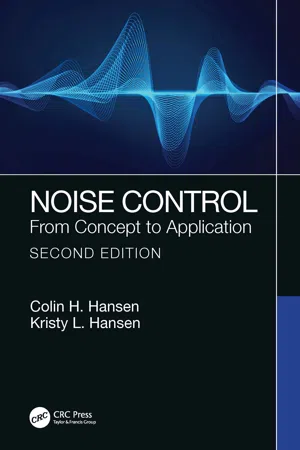
- 488 pages
- English
- ePUB (mobile friendly)
- Available on iOS & Android
About this book
The second edition of Noise Control: From Concept to Application, newly expanded and thoroughly updated, now includes 180 graded problems with solutions, plus 100 end-of-chapter problems with solutions available for instructors on the authors' website. Working from basic scientific principles, the authors show how an understanding of sound can be applied to real-world settings, working through numerous examples in detail and covering good practice in noise control for both new and existing facilities.
It covers the essential topics for industrial noise control: acoustics, noise criteria, hearing-damage risk, noise-assessment measures, measurement instrumentation, sound-source types including the calculation and measurement of their output power, sound propagation outdoors, sound in rooms, sound-absorbing materials, sound transmission through partitions and enclosures, noise barriers, reactive and dissipative muffler-noise reduction and muffler-design considerations such as pressure loss and self-noise generation.
Detailed explanations of important concepts make this textbook easy to understand by engineering and science undergraduates, as well as professionals with no background in acoustics.
Authors' website: www.causalsystems.com
Colin H. Hansen is Emeritus Professor in Mechanical Engineering at the University of Adelaide, Australia, and past President of the International Institute of Acoustics and Vibration.
Kristy L. Hansen is a Senior Lecturer in Mechanical Engineering at Flinders University, Australia, and holder of the Australian Research Council's Discovery Early Career Researcher Award.
Frequently asked questions
- Essential is ideal for learners and professionals who enjoy exploring a wide range of subjects. Access the Essential Library with 800,000+ trusted titles and best-sellers across business, personal growth, and the humanities. Includes unlimited reading time and Standard Read Aloud voice.
- Complete: Perfect for advanced learners and researchers needing full, unrestricted access. Unlock 1.4M+ books across hundreds of subjects, including academic and specialized titles. The Complete Plan also includes advanced features like Premium Read Aloud and Research Assistant.
Please note we cannot support devices running on iOS 13 and Android 7 or earlier. Learn more about using the app.
Information
1
Fundamentals
- fundamentals and basic terminology of noise control;
- noise-control strategies for new and existing facilities;
- the speed of sound and the wave equation;
- plane and spherical waves;
- energy density; sound intensity and sound power;
- decibels and sound pressure level;
- frequency analysis and sound spectra;
- adding and subtracting sound pressure levels and combining level reductions; and
- three kinds of impedance.
1.1 Introduction
Table of contents
- Cover
- Half Title
- Title Page
- Copyright Page
- Dedication
- Contents
- Preface
- 1 Fundamentals
- 2 Loudness, Descriptors of Noise, Noise Criteria and Instrumentation
- 3 Sound Sources and Sound Power Measurement
- 4 Sound Propagation Outdoors
- 5 Sound-Absorbing Materials
- 6 Sound in Rooms
- 7 Partitions, Enclosures and Barriers
- 8 Muffling Devices
- A Properties of Materials
- References
- Index